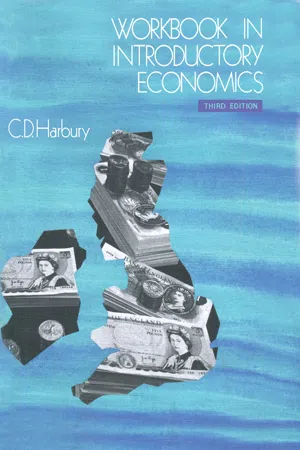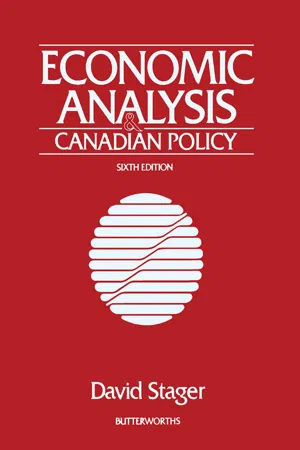Economics
Market Demand
Market demand refers to the total quantity of a good or service that all consumers in a market are willing and able to purchase at various prices during a specific time period. It is determined by the individual demands of all consumers in the market and is influenced by factors such as price, consumer preferences, and income levels.
Written by Perlego with AI-assistance
Related key terms
1 of 5
7 Key excerpts on "Market Demand"
- eBook - PDF
- Irvin B. Tucker, Irvin Tucker(Authors)
- 2016(Publication Date)
- Cengage Learning EMEA(Publisher)
Demand represents the choice-making behavior of consumers, while supply represents the choices of producers. The chapter begins by looking closely at demand and then supply. Finally, it combines these forces to see how prices and quantities are determined in the marketplace. Market Demand and supply analysis is the basic tool of microeconomic analysis. IN THIS CHAPTER, YOU WILL LEARN TO SOLVE THESE ECONOMICS PUZZLES: • What is the difference between a “ change in quantity demanded ” and a “ change in demand ” ? • Can Congress repeal the law of supply to control oil prices? • Does the price system eliminate scarcity? Copyright 2017 Cengage Learning. All Rights Reserved. May not be copied, scanned, or duplicated, in whole or in part. Due to electronic rights, some third party content may be suppressed from the eBook and/or eChapter(s). Editorial review has deemed that any suppressed content does not materially affect the overall learning experience. Cengage Learning reserves the right to remove additional content at any time if subsequent rights restrictions require it. ............................................................................................................................................................................................. ............................................................................................................................................................................................. 3-1 THE LAW OF DEMAND Economics might be referred to as “ graphs and laughs ” because economists are so fond of using graphs to illustrate demand, supply, and many other economic concepts. Unfor-tunately, some students taking economics courses say they miss the laughs. Exhibit 1 reveals an important “ law ” in economics called the law of demand . The law of demand states there is an inverse relationship between the price of a good and the quantity buyers are willing to purchase in a defined time period, ceteris paribus. - Available until 8 Feb |Learn more
- L Engelbrecht, A Strydom, L Engelbrecht, A Strydom(Authors)
- 2014(Publication Date)
- Future Managers(Publisher)
In such markets, the buyer and seller do not have market power which would enable one to manipulate the other. Perfectly competitive markets have the following characteristics: • Number of buyers and sellers : there are literally thousands of participants in the market resulting in much choice. • homogenous product : The products being offered by sellers are identical or uniform. • there is perfect information : Buyers and sellers know everthing about the characteristics of the product and can easily compare the prices of sellers. • No barriers to entry or exit : Buyers and sellers can enter and leave the market at will. No licencing approval or other restrictions prevent a seller from competing. • Sellers are price takers : as sellers have no market power, they are forced to take the price determined by the market. This ensures an acceptably low price for buyers. 2.1 Demand 2.1.1 Description Demand is the quantity of a good or service that a consumer is willing and able to purchase at a given price, place and time ceteris parabus (all things being equal). Figure 2.1 Composition of a market How the markets work 21 FutureManagers 2.1.2 What determines the quantity demanded Numerous factors influence the demand for a good or service. The price of the product The price of the good will determine the quantity which the consumer is willing and able to purchase. The law of demand dictates that buyers will always demand more at a low price and less at a high price. The prices of other products As the price of related goods changes, so does the consumer’s ability and willingness to purchase the good in question. This is because related goods have an effect on demand for the good in question. Such related goods can be: Complementary These are goods that are consumed together (in conjuction)with other goods. Such goods are dependent on each other. Examples are cars and petrol or computers and printers. - eBook - PDF
- Colin Harbury(Author)
- 2014(Publication Date)
- Pergamon(Publisher)
The forces of supply and demand working through the price mechanism can be thought of as helping to solve the central economic problems of any society. Prices act, as it were, as signals which perform two functions. (i) Prices signal to suppliers the demand for different goods and services. Comparing prices with costs, producers can decide how to allocate resources in order to maximise profits. (ii) Prices signal to buyers the costs of acquiring different goods and services. Comparing prices with the satisfaction that goods bring, buyers can decide how to allocate their expenditure in order to maximize their satisfaction. In changing circumstances, prices act as signals to producers to adjust the allocation of resources. Prices also function to ration a limited supply among those who are prepared to pay most for it. The DEMAND for a commodity is generally thought of as being by 'consumers' (or 'households'). It is rarely for a fixed amount, but is considered as a SCHEDULE of quantities which would be bought in the course of a given period of time at various prices. It is sometimes referred to specifically as the schedule of EFFECTIVE DEMAND to emphasize that it is not mere desires which are relevant but wants backed by preparedness to buy. The relationship between demand and price may be portrayed graphically as a DEMAND CURVE, with price plotted on the vertical axis and the quantity demanded on the horizontal axis. Market Demand is made up of the demands of all individual consumers, and there is an observed tendency for demand curves to slope downwards to the right. This may be explained in two ways. First, as price falls, the number of persons entering the market as purchasers tends to increase. Second, as price falls, there is a tendency for each individual consumer to demand more. The second reason is related to the principle of DIMINISHING MARGINAL UTILITY. - eBook - PDF
- David Stager(Author)
- 2013(Publication Date)
- Butterworth-Heinemann(Publisher)
Since the Market Demand curve is a summation of individuals' demand curves, the special features of the individual demand curves are also applicable to the Market Demand. Shifts in Market Demand and changes in the quantity demanded by the market are defined in the same manner as for individuals. But moving to the market level intro-Consumer A Consumer Β Total Market (A -i- B) Quantity (units per time period) Figure 3.3 Adding individuáis' Demand Provides IVIarlcet Demand The Market Demand curve, D^, is derived by adding horizontally the individual demand curves for all consumers in the market. less—if the consumer expects that the price will increase still further. For this introductory analysis, however, the assumption is that prices are expected to remain stable. 40 Chapter Three duces further factors causing shifts in demand, namely an increase in the population and its greater total income, as well as the distribution of that income. The greater total income will usually increase demand, but the effect on different commodities will depend on how the income is distributed. Elasticity: Sensitivity to Price Changes That the quantity demanded will increase as the price of a good falls, all other things being equal, usually comes as no surprise to anyone. It is more important to know how sensitive consumers are, or how strongly they react, to a price change. The concept of elasticity is used to measure this quantitative relationship between the price change and the resulting change in quantity demanded. The general concept of elasticity is defined as the percentage change in one variable resulting from a given percentage change in another variable. Price Elasticity of Demarid The measure of the relationship of price and quantity demanded is termed price elasticity of demand. - eBook - PDF
- Tucker, Irvin Tucker(Authors)
- 2016(Publication Date)
- Cengage Learning EMEA(Publisher)
2 MICROECONOMICS FUNDAMENTALS In your study of the microeconomy, the chapters in Part 2 build on the basic concepts you learned in Part 1. Chapters 3 and 4 explain the Market Demand and supply model, which has a wide range of real-world applications. Chapter 5 takes a closer look at movements along the demand curve introduced in Chapter 3. Chapter 6 returns to the law of demand and explores in more detail exactly why consumers make their choices among goods and services. Part 2 concludes in Chapter 7 with an extension of the concept of supply that explains how various costs of production change as output varies. Copyright 2017 Cengage Learning. All Rights Reserved. May not be copied, scanned, or duplicated, in whole or in part. Due to electronic rights, some third party content may be suppressed from the eBook and/or eChapter(s). Editorial review has deemed that any suppressed content does not materially affect the overall learning experience. Cengage Learning reserves the right to remove additional content at any time if subsequent rights restrictions require it. . . . . . . . . . . . . . . . . . . . . . . . . . . . . . . . . . . . . . . . . . . . . . . . . . . . . . . . . 3 Market Demand AND SUPPLY A cornerstone of the U.S. economy is the use of markets to answer the basic economic questions discussed in the previous chapter. Consider baseball cards, Blu-rays, physical fitness, gasoline, soft drinks, and sneakers. In a market economy , each is bought and sold by individuals coming together as buyers and sellers in markets. This chapter is extremely important because it introduces basic supply and demand analysis. This technique will prove to be valuable because it is applicable to a multitude of real-world choices of buyers and sellers facing the problem of scarcity. For example, the Global Economics feature asks you to consider the highly controversial issue of international trade in human organs. - Berkeley Hill(Author)
- 2013(Publication Date)
- Pergamon(Publisher)
For example, if income tax is increased on unmarried men and decreased on married men, leaving in taste towards good Swing in taste away from the good 62 An Introduction to Economics for Students of Agriculture average spendable income unchanged, it could be expected that the demand for sports cars in the country as a whole would decline but the demand for family saloons would increase. SHIFTS ALONG THE DEMAND CURVE AND SHIFTS OF THE WHOLE DEMAND CURVE FOR A COMMODITY To conclude this section on demand, it is worth recapitulating on the ways the factors described above affect the demand curve. A demand curve shows the quantities of a commodity which consumers are willing and able to take from the market at a range of given prices of the com-modity. If the price of the commodity is altered, because a shift in the supply curve causes the demand curve and the supply curve to intersect at a different level, more (or less) will be bought; this involves a move-ment along the demand curve. However, the whole curve will be shifted to the left or right by a change in consumer income, a change in the prices of competitive or complementary goods, changes in taste, popula-tion changes or a change in the distribution of incomes between house-holds. Having considered the demand for commodities in detail, the same approach will now be adopted to the supply of goods and services. B. The Theory of Supply THE MEANING OF SUPPLY AND FACTORS WHICH DETERMINE IT The supply of a commodity can be defined as the quantity that pro-ducers are willing and able to offer for sale in a given time period. Like demand, supply is a flow of goods and services. The supply of any good depends on five factors: (a) the price of the good (PA) (b) the prices of other goods which firms could produce or do produce (PB, .... ΛΟ (c) the prices of factors of production i.e.- eBook - PDF
Microeconomics
Principles and Policy
- William Baumol, Alan Blinder(Authors)
- 2015(Publication Date)
- Cengage Learning EMEA(Publisher)
Due to electronic rights, some third party content may be suppressed from the eBook and/or eChapter(s). Editorial review has deemed that any suppressed content does not materially affect the overall learning experience. Cengage Learning reserves the right to remove additional content at any time if subsequent rights restrictions require it. Chapter 5 Consumer Choice: Individual and Market Demand 99 The consumer demand analysis presented in this chapter, although correct as far as it goes, has (at least) one shortcoming: By treating the consumer’s decision about the purchase of each commodity as an isolated event, it conceals the fact that consumers must choose among commodities because of their limited budgets. The analysis so far does not explicitly indicate the hard choice behind every purchase decision—the sac-rifice of some goods to obtain others. The idea is included implicitly, of course, because the purchase of any commodity involves a trade-off between that good and money. If you spend more money on rent, you have less to spend on entertain-ment. If you buy more clothing, you have less money for food. But to represent the consumer’s choice prob-lem explicitly, economists have invented two geomet-ric devices, the budget line and the indifference curve, which are described in this appendix. Geometry of Available Choices: The Budget Line Suppose, for simplicity, that only two commodities are produced in the world: cheese and rubber bands. The decision problem of any household is then to allocate its income between these two goods. Clearly, the more it spends on one, the less it can have of the other. But just what is the trade-off? A numerical example will answer this question and introduce the graphical device that economists use to portray the trade-off. Suppose that cheese costs $2 per pound, boxes of rubber bands sell at $3 each, and a consumer has $12 at his disposal. He obviously has a variety of choices, as displayed in Table 4.
Index pages curate the most relevant extracts from our library of academic textbooks. They’ve been created using an in-house natural language model (NLM), each adding context and meaning to key research topics.






